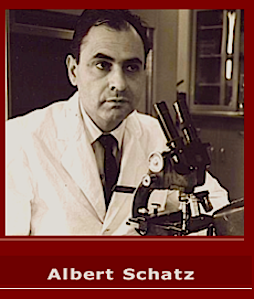| State Of Wisconsin |
Circuit Court |
Fond Du Lac County |
|
SAFE WATER ASSOCIATION, INC.,
|
| Plaintiff,vs.CITY OF FOND DU LAC,Defendant. |
|
Case No. 92 CV 579 |
|
AFFIDAVIT OF ALBERT SCHATZ, Ph.D.
IN SUPPORT OF MOTION FOR SUMMARY JUDGMENT
State of Pennsylvania
City of Philadelphia
Albert Schatz, Ph.D., being first duly sworn on oath and with personal knowledge of the information contained herein,
respectfully states to the Court as follows: |
BACKGROUND
1. I received my B.Sc. in 1942 in Soil Chemistry, and my Ph.D. in 1946 in Soil Microbiology, each from Rutgers University.
2. I have held numerous academic positions. Since 1980, I have been a Senior Professor at Temple University.
3. At the age of 23, I discovered the antibiotic Streptomycin. This compound was the first effective drug for the treatment of human tuberculosis.
4. I have been awarded honorary degrees and titles by the University of Chile, the Autonomous University of Santo Domingo, the Federal University of Espirito Santo in Brazil, the National University of San Antonio Abad del Cuzco in Peru, and the University of Bogota in Colombia.
5. I have been named an honorary member of the Scientific Society of Chile, the Chilean Society of Pediatrics, The Academy of Oral Dynamics (USA), the Stomatological Society of Greece, and many others.
6. I am also a Fellow of the Royal Society of Health in Great Britain.
7. I have published three books, and more than 500 articles in scientific and professional journals, and in popular magazines and newspapers.
8. On the subject of fluoridation, I have published numerous articles, including:
- The Failure of Fluoridation in Chile, Pakistan Dental Review, 1967; 15:83.
- Failure of Fluoridation in the United Kingdom. Pakistan Dental Review, 1972; 22:3.
- The failure of fluoridation in England. Manchester Union Leader, Jan 27, 1973.
- Censorship suppresses information unfavorable to fluoridation. Divulgacion Cultural Odontologica, 1975; 110:32.
- Increased death rates in Chile associated with artificial fluoridation of drinking water. Journal of Arts, Sciences and Humanities. 1976; 2:1.
9. From 1962 to 1965 I lived in Chile. During that time I served as a Professor at the University of Chile, and worked in the Faculty of Medicine, the Faculty of Dentistry, the Faculty of Agriculture, and the Faculty of Philosophy and Education. I was also associated with numerous projects in the Ministry of Health, Ministry of Agriculture and the Ministry of Education.
EXPERIENCE CONCERNING THE DANGERS OF FLUORIDATION
- Chile began to experiment with artificial fluoridation in 1953. By the 1960s, it became clear to me that fluoridation was causing serious harm, and I undertook a study which showed increased death rates in Chile associated with artificial fluoridation. My dramatic findings were later published. (Exhibit____).
- My first finding is perhaps the most disturbing. Those authorized to study and review the safety and effectiveness of fluoridation consistently distorted the data to achieve the desired results.
- When the data for the three “test” cities in Chile were examined, Curico, F 1 ppm, San Fernando F 0.0 ppm, and La Serena 0.67 ppm, the only possible conclusion was that fluoridation was causing significant numbers of deaths.
- Consider, for example, the deaths resulting from congenital malformations as a percent of the total number of deaths. Curico has 244% more such deaths than San Fernando, and 94% more than La Serena. (Exhibit____, table 1).
- Infant mortality rates in Curico were 69% greater than in San Fernando and La Serena. (Id, table 2).
- For a fuller understanding of some of the harmful effects caused by fluoridation, read exhibit____. Chile abandoned artificial fluoridation shortly after I sent copies of my report to all dental and medical officers in the Pan American Health Organization.
- In Chile, with widespread malnutrition and high infant mortality, it was not necessary to observe a generation of people throughout their entire life-span in order to determine whether artificial fluoridation is or is not harmful. One could see the lethal effect of fluoridation within the first year of life in terms of increased infant mortality due to acute toxicity of fluoride. Some other adverse effects, like congenital malformations, may or may not cause death.
- In the US, the harmful effects of artificial fluoridation are not so clearly revealed by large-scale, comparative studies of the total populations of fluoridated and control cities, because Americans as a whole are in a considerably better state of nutrition than Chileans.
- Nonetheless, artificial fluoridation of drinking water may well dwarf the thalidomide tragedy, which was dramatic because it produced crippled children who are living testimonials to what that drug has done. Many victims of artificial fluoridation, on the other hand, die quietly during the first year of their lives, or at a later age under conditions where their deaths are attributed to some other cause.
EFFECTIVENESS OF FLUORIDATION
- In 1969, the British Committee on Research into Fluoridation reported the fluoridation of water supplies is a highly effective way of reducing caries. My published analysis of the data, with Dr. Joseph Martin, shows that fluoridation does not protect against tooth decay. (Exhibit____).
- The data clearly showed that fluoridation only delays the appearance of caries. For example, 10-year-old fluoridated and 8.8-year-old control children had about the same DMFT. A comparison of other corresponding age groups shows a similar delay of approximately 1.2 years in the appearance of caries. (Exhibit ___, figure 2).
- Fluoridation merely postpones the appearance of caries. Fluoridated children develop the same amount of tooth decay as their non-fluoridated counter-parts over their lifetime. The only difference is that caries start developing approximately 1.2 years later.
- There is no economic benefit for such actions. Since fluoride does not reduce caries, fluoridated and control children will develop the same amount of tooth decay. Both groups will therefore require the same amount of dental treatment. People in fluoridated areas therefore pay for the same amount of dental treatment plus the added cost of fluoridation.
REFUSAL TO CONSIDER ADVERSE EVIDENCE
- On the strength of the data I had analyzed in Chile, I wrote L.C. Hendershot, editor of the Journal of the American Dental Association. I asked him if he would be interested in seeing my report of increased death rates, and if he would consider it for publication in JAMA.
- When he did not reply to that letter of inquiry, I sent him three copies of the report in January, February, and March of 1965. Dr. Hendershot refused to accept all three communications, which were therefore returned to me, unopened. Copies of the certified envelopes, marked refused, are figure 3, exhibit____.
- Such a response is typical of the proponents of fluoridation. The professional sanctions for opposing fluoridation can be severe, and it is best not to even acknowledge evidence of harm or ineffectiveness.
CONCLUSION
- Artificial fluoridation has not been as widely accepted as its proponents imply. Many cities in the US have discontinued fluoridation after starting it. Virtually all of Europe has considered and abandoned fluoridation.
- Because artificial fluoridation causes deaths among individuals who are for one reason or another more sensitive to fluoride toxicity than the total population taken as a whole, the controversy over whether fluoridation does or does not reduce caries is purely academic. It is criminal to implement a so-called public health measure which kills certain people even if it does reduce tooth decay in some of the survivors. As noted, the evidence is that it merely delays decay.
- It is my best judgment, reached with a high degree of scientific certainty, that fluoridation is invalid in theory and ineffective in practice as a preventive of dental caries. It is dangerous to the health of consumers.
- I make this Affidavit in support of the Plaintiff’s Motion for Summary Judgment.
______________________________________________________________
Press Release, 30 June 1993 | Update, 25 June 1993 | Sherrell transcript, 1992 |
AFFIDAVITS: Frank Bertrand, B.D.S. | Albert W. Burgstahler, Ph.D. | Robert J. Carton, Ph.D. | John Colquhoun, D.D.S. | Mark Diesendorf, Ph.D. | Richard G. Foulkes, M.D. | Sheila L. M. Gibson, M.D. | John Remington Graham, Esq. | Gerard F. Judd, Ph.D. | George W. Kell, Esq. | David C. Kennedy, D.D.S | Robert Roy Kintner, Ph.D. | Lennart Krook, D.V.M., Ph.D. | John R. Lee, M.D. | William L. Marcus, Ph.D., D.A.B.T. | Jim Maxey, D.D.S | Hans C. Moolenburgh, M.D. | H. J. Roberts, M.D. | Jan F. Sallstrom, Ph.D | Albert Schatz, Ph.D. | A.K. Susheela, Ph.D. | Philip R. N. Sutton, B.D.Sc. | Deloss E. Winkler, Ph.D. | exhibits list |



